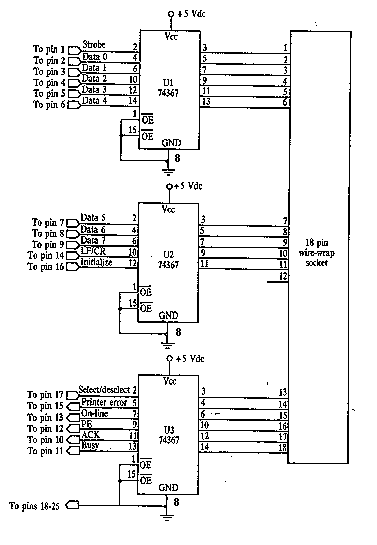
So you've read about my Computerized Room or have seen those nifty home automation products advertised in the back of electronics magazines? Or perhaps someone you know has done something similar. At any rate, you have decided to try it yourself. The first thing I will say, however is that it is not cheap.
You will first need a computer, but since your reading this, I assume that you already have that taken care of. Second, you will have to buy about 20 IC's and a very expensive ISA experimenters prototyping board. These boards cost anywhere from $16 to $45, and can be purchased from your local electronics store or from Jameco Electronics. They have a fairly wide selection. Buy the 8 bit version, the 16 bit varsion is not needed for this project.
Since this is a major project, it will be presented in sections, starting with the Simple Parallel Port Interface. The 8 Bit Output Card will come next, followed by the 8 Bit Input Card. All three interfaces came from the book "The Robot Builders Bonanza", by Gordan McComb.
I must also stress that this is a major project and should not be attempted unlesss you have a good understanding of electronics. If done wrong, you run the risk of not only destroying the circuit, by also destroying an expensive computer as well. Double, no, triple check your work to make absolutely sure that is free from errors before installing it in any computer.
DISCLAIMER: I am not responsible for any damages caused due to a lack of knowledge or mistakes in the circuit when building and using these projects.
Now then, with that out of the way, on to the Parallel Port Interface.
U1,U2,U3______74367, 74LS367, Etc. Buffer
MISC__________Sockets, 18 Pin Socket (For Output), Board, Ribbon
Cable, 25 Pin Connector
You operate the interface by sending bit patterns to the
printer port. BASIC, GWBASIC or QBasic are the languages of
choice since most computers already have them installed (in your DOS
directory).
The command you use is the OUT command. The
decimal address of most printer ports (assuming LPT1) is 888. Use
this with the OUT like this:
OUT 888,X
X is a number from 0 to 255 that represents the
binary bit pattern.
Although designed primarily to get data out of the computer,
the printer port has 5 input lines (on some computers it could be
less). You access these lines with the INP function.
This time, however, the decimal address is 889. The syntax of the
INP command is:
Y=INP(X)
Y is the variable used to store the decimal value
that is returned. X is the port number, which in
this case is 889.
You may also use the OUT command to send data to
the address lines. Just use address 890 instead of 888. Remember
that there are only 4 address lines.
OK. With the basic parallel port interface done, you can build the more advanced 8 Bit Output Card.
This interface is constructed on an IBM 8 bit prototyping board. These are available from Jameco Electronics.Connections are made with point to point soldering or wire wrap. Note that if you use the wire wrap method the board will require about 1/2 inch clearence on the connection side.
Use sockets for all IC's. Begin construction by first mounting the sockets. Depending on which board you buy, you might have lots or very little space. Connect the IC's together using either point to point or wire wrap. I used a 36 pin connector to facilitate connection to the back of the computer, but you can use any other method. Whatever the method, install that connector and wire it into the circuit now. You may now wire the connections to the bus (the gold contacts on the bottom of the card). It is a good idea to bypass power supply pins with .1uf capacitors to avoid problems with interference, power supply spikes, etc. Triple check your work before installing the circuit in any computer. The simple circuit to connect the interface to relay's is showen after the schematic.
U1_________7404 Inverter
U2_________7400 NAND Gate
U3_________7432 OR Gate
U4_________74374 Buffer
U5_________7430 8 Input NAND Gate
MISC_______8 Bit IBM Prototyping Board, Connector (For
Output/Input), Sockets, Capacitors For IC Bypass, Wire.
The power connections were left off the schematic for clarity. Here they are:
Chip | Vcc | GND
--------------------
7400 | 14 | 7
7404 | 14 | 7
7430 | 14 | 7
7432 | 14 | 7
74374 | 20 | 10
CAUTION: Be sure that the signals being sent to the input card do not exceed 5 volts or fall below ground!
U1_________7404 Inverter
U2_________7400 NAND Gate
U3_________7432 OR Gate
U4_________74244 Buffer
U5_________7430 8 Input NAND Gate
The power connections were left of the schematic for clarity. Here they are:
Chip | Vcc | GND
--------------------
7400 | 14 | 7
7404 | 14 | 7
7430 | 14 | 7
7432 | 14 | 7
74244 | 20 | 10
Controlling the cards is straight forward, using the basic INP
and OUT statements as explained in the Simple Parallel Port Interface. The only
difference is the address. The address for the input card is
decimal 701 while the output card is decimal 703.
This is the last section of this document. Choosing the right computer is not that big of a concern. Anything from an old 8086 to IBM's new Deep Blue supercomputer will work. Just make sure that you triple check your work before installing it into any computer.